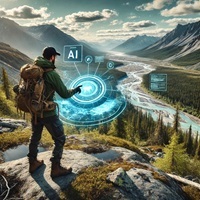Image. Showing an adventure traveller using AI technology to search for untouched places. Generated by DALL·E 2 - ChatGTP4 from OpenAI.
Experience the thrill of discovering hidden gems. Whether you are seeking untouched nature, wildlife, exotic tribes, charming villages, or secret spots filled with history, there are still lot of hidden gems in the world to spark your wanderlust.
Think of it this way: each step off the beaten track is a step into the extraordinary, where every moment is a story waiting to be told. Venture beyond the familiar, embrace the unknown, and let the world reveal its most enchanting secrets to you. But how to find these places?
AI - Artificial Intelligence - offering travellers the ability to uncover untouched, hidden destinations in ways that are more informed, personalised, and eco-conscious. When searching for untouched or lesser-known destinations, travellers can use AI-powered tools to find information that traditional search methods might miss.
For instance, ChatGPT even offers a specialised service for travellers via Travel Guide (capchair.com), a travel-specific chatbot which provides expert advice on global destinations, trip planning, budgeting, and exploring the world.
Why use AI for travel?
The benefits of AI in travel are vast, including:
- Enhanced search capabilities: AI tools analyse data far more effectively than basic search engines and find unique places.
- Personalised itineraries: AI tailors recommendations based on your preferences, offering custom experiences.
- Cultural and language adaptation: Tools like AI-powered translators help to reduce communication gaps and give deeper cultural insights.
- Real-time flexibility: AI provides real-time updates on weather, transport, and events, ensuring your plans remain adaptable.
Use of Google map AI
A starting point is using existing AI tools like Google Maps' “explore” feature. You can use search terms like "hidden gems," "untouched places," or "quiet spots," and then focus on places with fewer reviews or mentions. Another example of term for searching by using Google Maps or a similar tool is: “hidden hiking spots near [your location].” The AI in these tools make suggestions based on patterns in location searches.
How to create effective prompts
To find untouched or unexplored places using for example ChatGPT, crafting effective prompts is the key. Creating effective prompts to get precise and useful information about travel destinations involves several key skills. These skills help refine your requests and ensure the results are tailored to your needs.
The ability to be clear and specific with your request is crucial. If you are vague, the results might not align with your intentions. Always include specific elements like the location, activity, and type of experience you are looking for. Before starting your search, you need to have a clear understand about the difference between the terms "untouched" and "unexplored" (read more in this article below “Additional Information”.
Formula prompts
Based on my experience, the RTF formula can help you create clear and effective prompts. Breake them down into three key elements: Role, Task, and Format. For example: "As an adventure travel expert (R), suggest remote and challenging trekking routes in the Balkans (T), and provide details on difficulty, terrain, and best seasons to visit (F)."
This structure helps ensure you are providing all the necessary details to get a precise and useful response.
Dialog-based prompts
Not every prompt needs to be long and full of details. Dialog-based prompts are also a great way to make requests or queries conversational, which can lead to more natural, creative responses from AI tools like ChatGPT. These types of prompts encourage a back-and-forth flow and can help refine your requests when looking for unique information or insights - for different intentions and situations, for example:
You: “I’m looking for an off-the-beaten-path destination in Europe. Can you suggest a place that’s not crowded but still beautiful?”
Other examples of simplified dialog-based prompts:
- "Find remote natural landscapes in South America that are not popular among tourists and have minimal infrastructure."
- "Recommend lesser-known mountain ranges in Asia that are difficult to access but have stunning natural beauty."
- "Suggest off-the-beaten-path villages in Africa that have maintained traditional customs and are surrounded by unique landscapes."
- "What are some forgotten ancient ruins in Central America, away from major tourist spots?"
- "Suggest remote islands in the South Pacific that have limited or no commercial tourism."
- "Where can I go for a wilderness camping experience in Europe that offers isolation and unspoiled nature?"
- "What are some beautiful but difficult-to-reach deserts or tundras that few people visit?"
- "Find hidden eco-tourism spots in Southeast Asia that promote sustainability and are far from mainstream tourist paths."
- "Recommend places that offer a sense of discovery and untouched beauty that few travelers know about."
- "Suggest hidden historical sites in Finland that are not part of typical tourist routes but have significant cultural or local importance."
These types of queries help AI tools like ChatGPT offer more tailored suggestions. By using the last mentioned prompt, you will find locations that provide a unique way to explore Finland`s lesser-known history and offer a deeper, more personal connection to its cultural past.
Using AI for more in-depth exploration
As mentioned, unlike traditional search methods, AI-powered tools can help travellers discover hidden gems that may otherwise go unnoticed.
Most search engines use basic keyword matching, but AI tools like ChatGPT or machine learning-powered search engines use natural language processing (NLP) to understand the intent behind your search. This means you can search with more conversational queries. Example: Instead of typing "untouched beaches in Asia," you could ask: “What are some remote beach destinations in Southeast Asia that aren't crowded by tourists?” The AI understands not just the "untouched beaches" part, but also interprets the “aren’t crowded” part, helping you find destinations that match exactly what you’re looking for.
Start by using AI-tools like this one or even travel-specific chatbots that utilise NLP. Ask them more nuanced questions based on your specific interest (remote, untouched, sustainable, etc.). This often leads to more detailed results than traditional search engines. AI’s ability to interpret conversational input and draw data from different sources makes it easier in that way to find places that don’t show up in mainstream searches.
AI tools aren't just good for finding places – they can also analyse patterns in search data, user reviews, and historical information. For example, AI can help you determine whether a place is truly untouched or if it's becoming more popular over time. Example: Let's say you're looking at a destination in a remote part of Iceland. You can ask an AI: "Has tourism in this region increased in the past 5 years?"
AI can process data from travel blogs, forums, and social media to give you a clearer idea of whether that place is still as untouched as you'd like. Use AI to cross-check multiple sources of data. For example, you could ask, "Are there a lot of recent posts about this place on social media?" or "What do travel forums say about this destination's visitor numbers?"
Once you have identified an untouched place and checked its popularity trends, it’s time to understand its culture and sustainability practices. Knowing this adds depth to your travel experience and helps you make responsible travel decisions. Example: Let’s say you’ve discovered a remote village in Nepal. You can ask: “What are the cultural traditions of this region?” AI can search and analyse historical documents, travel blogs, and local websites to give you an overview of the region's traditions, festivals, and daily life.
Now that you have learned how to find, analyse, and understand untouched places, the next step is personalising your travel experience. AI can be your virtual travel assistant, helping you build a unique itinerary based on your interests, whether natural wonders, historical sites, diving, hiking, or simply seeking quiet corners away from the tourist trail.
AI can help by learning from your preferences, combining insights about the destination with recommendations that align with your style of travel. The benefit of AI is that it can customize your trip down to the smallest detail, ensuring that your experience in these untouched places is one-of-a-kind. Example: Let’s say you are passioned about hiking and photography. You can ask: “Can you recommend lesser-known hiking trails in Patagonia that are great for landscape photography?”
AI can also be useful for translation. AI translation tools (like Google Translate or DeepL) are powered by sophisticated machine learning algorithms, allowing real-time translation between you and locals. But beyond basic translation, AI can help you understand cultural nuances and avoid misunderstanding.
Critical thinking when using AI
Don`t be fooled or misleaded by AI due to incorrect information . Be critical and check information, or you will end up in a place that don’t meet your expectations, or even worse don`t exist. While AI offers incredible advantages, it is essential to approach its results with a critical eye. AI can process vast amounts of data, but it doesn't "understand" in the way humans do. AI tools, like ChatGPT, generate responses based on patterns in the data they’ve been trained on. This means there’s always a risk of inaccuracies or outdated information. Always cross-check the data with trusted sources to ensure accuracy.
You can even use several AI tools to cross-check information and see what they are coming up with. You can also ask follow-up questions to get a deeper understanding. Another approach is to ask for sources for the information. Then you can simply request a citation or reference by saying something like:
- “Can you provide the sources for this information?”
- “Where did this information come from?”
- “Can you cite any references for this?”
If the information is generated from general knowledge or expertise, you may not always provide direct sources. However, if you are asking about something current or specific, you can use the browser tool to search for up-to-date sources and share citations.
By using multiple AI tools and reliable sources, you can ensure that your travel planning is both informed and accurate.
In conclusion, AI is revolutionizing the way we discover untouched destinations, providing travellers with deeper insights and personalised experiences. By combining AI's capabilities with critical thinking, you can unlock the world’s hidden gems and create unforgettable, responsible travel adventures.
Stein Morten Lund, 26th September 2024
Additional information
Note: This article is written with assistance and experimenting with ChatGTP, Travel Guide Av capchair.com, and MS Copilot.
Before using AI for finding unique places, it’s essential to define what you mean by “untouched” or “unexplored.” This can vary depending on personal perspectives or cultural significance. To some, it could mean a place that's not commercialized or mass-visited, while to others, it could mean a region where few travelers have ventured.
For practical purposes, keep in mind these definitions:
- Untouched places: Locations with minimal human interference or development, often in their natural state.
- Unexplored places: Places that are less documented, with little online presence or tourist traffic, though not necessarily new in the geographical sense.
Read our article about useful AI apps for travel adventurers on our website.












